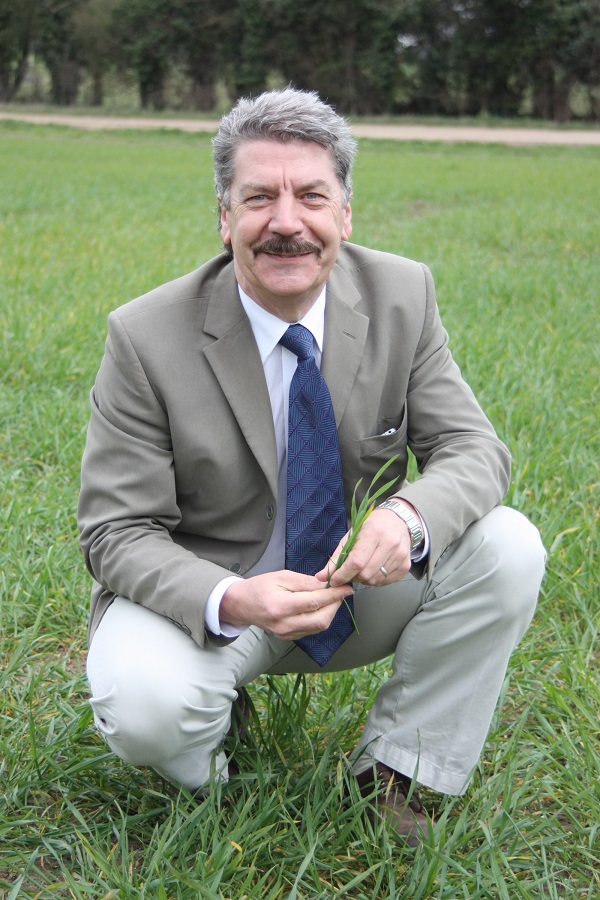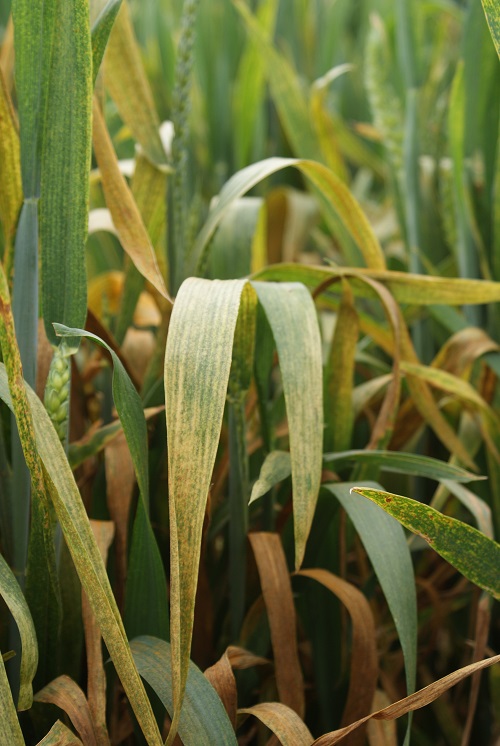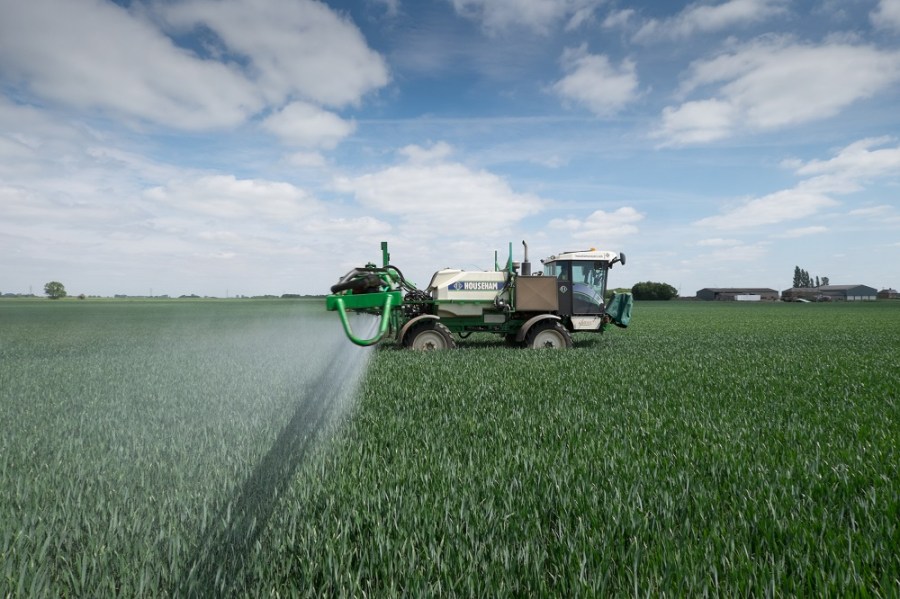Spoilt for choice with new SDHI options? CPM finds out factors to consider when shaping strategies this season (part 2 – see here for part 1).
I’d describe the T2 flag leaf spray as a compromise.
By Lucy de la Pasture
With Ascra Xpro (bixafen+fluopyram+ prothioconazole) and Elatus Era (benzovindiflupyr+ prothioconazole) joining the SDHI ranks this spring, how will this affect the positioning of SDHIs in the fungicide programme?
Senior agronomist at TAG Consulting, Chris Page, believes the new additions will help strengthen septoria control.
“The arrival of Ascra and Elatus increases our armoury further and we already have plenty of choice. What these two bring to the party is an uplift in septoria protection and curativity. It doesn’t mean our existing portfolio doesn’t have a role, but where septoria is a concern, they are natural fits,” he says.

Damian McAuley points out many SDHIs are really protectants so hitting the correct leaf layer accurately is important
Voted last season’s Food and Farming Awards Agronomist of the Year, AICC member Damian McAuley is in broad agreement.
“Over the past few seasons my choices have been centred around Aviator (bixafen+ prothioconazole), Adexar (epoxiconazole+ fluxapyroxad) and an azole plus Vertisan (penthiopyrad). But the arrival of the two new offerings has added to the toolbox.
“I think with the potency that they possess, then Ascra and Elatus are good additional choices for either T1 or T2 timings depending on variety, weather and disease pressure,” he says.
“Unfortunately, sometimes ’s impossible to stay in a totally protectant position so some curative action is useful, but ideally we don’t want to put that to the test,” he adds.
Chris Page echoes the point about curativity, emphasising that it’s a situation to be avoided if possible.
“These new products do give us some flexibility when it comes to timing, but I don’t really want to go there. No product is fully curative or works to its optimum when poorly timed. But we have to recognise that in some seasons the weather will ruin the best laid spray plans.”
Damian McAuley points out that even with the SDHIs available, few of them are particularly curative.
“Many SDHIs are really protectants so hitting the correct leaf layer accurately is important. They do widen the spray window, but not by much,” he says.

Bill Clark explains that during the latent phase, while fruiting bodies are formed, they’re already effectively sealed against fungicide attack.
NIAB technical director Dr Bill Clark confirms that timing is an immensely important area when it comes to septoria control.
“I’d describe the T2 flag leaf spray as a compromise. You’re looking to protect the flag leaf but get some clean-up of leaf two. That will have been out on the main tiller for somewhere approaching ten days when the flag-leaf spray is applied,” he explains.
‘I think there’s a strong case for defaulting to our most potent options at T2. 40% of final yield is from the flag leaf, so protecting green leaf area on the run-up to, and during, grain fill is vital.
But the story isn’t just one of protection, but curativity too, he points out.
“At that time of the growing season, the time between leaf layers emerging is around ten days. With leaf two almost certainly infected when you apply the flag-leaf spray, you must be using a good eradicant fungicide to make sure you stop septoria on leaf two (which can be contributing about 25% of the yield).”
Bill Clark also believes it’s important to understand the septoria pathogen’s epidemiology when selecting the best product to do the job – particularly the latent period.
“The later you go into the latent period, the higher the dose required to give high levels of control. Eventually, if you wait too long, even the full label dose won’t give you good control,” he cautions.
“Even with more potent fungicides, timing is so important. Once the latent period is half-way through, even an eradicant fungicide is not going to touch the disease, even though symptoms are not yet visible,” he says.

One of the SDHIs weaker on septoria may be a better choice if yellow rust is the target.
So what’s happening within the plant during the latent phase? Bill Clark explains.
“As the pathogen’s mycelia spread inside the leaf, the next generation of infectious spores are already being formed inside pycnidia (fruiting bodies). Although invisible to the naked eye at this stage, those fruiting bodies are already effectively sealed against fungicide attack, and no fungicide is going to get into those pycnidia, not even an eradicant fungicide.”
And that latent phase could be half way though just five days after infection at that time of year.
“Even the most potent fungicides will only give you a few days breathing space. This is what happened to some growers in 2016 – there were enough wet days in May to get infection up on the top two leaf layers, but then this was followed by some high temperatures and prolonged rainfall in June.
“The high temperatures and prolonged leaf wetness were ideal for late development of septoria. Once infection has occurred, the epidemic is driven by temperature, so the high temperatures in June led to rapid development of the disease,” reminds Bill Clark.
“It highlights the weather volatility we can face – something that’s unique to farming. In June 2016, Northants saw solar radiation reduced by 40%. June 2015 couldn’t have been more different with numerous sunny days,” adds Chris Page.
“The top leaves are so important to yield optimisation that the T1 and T2 are critical components of a fungicide programme. If these sprays are compromised by poor weather, then it could seriously impair yield and grain quality.”
And that’s why fungicides need applying promptly, once key growth stages are hit, and certainly within a few days of an infection event, especially at the crucial T2 (GS39) timing, when the flag leaf is emerging, stresses Bill Clark.
Ben Giles, commercial technical manager at Bayer reckons that in most crops at the T2 timing, there’s likely to be some degree of latent or expressed septoria present on leaf three.
“Much of this is unlikely to be controlled by the T2 application as the disease has been there too long,” he comments.
The level of latent infection present in final leaf two is of more significance to the T2 application as this potentially can still be controlled by the strongest products, if not too far through the latent period.
“Infection is almost always going to be still in the latent phase in leaf two at the time the T2 application goes on, unless it has been out for a very long time as we saw in 2012. The levels of infection will be determined by weather after T1, the levels of infection further down the crop and variety. The better the RL rating the less latent infection in leaf two you’re likely to have,” he says.
“Modern varieties seem to have a more vertical leaf emergence meaning they can often come out and almost immediately be brushing against already infected leaves further down the canopy. This means the first place you’ll get infection is likely to be the leaf tip and so the tip of leaf three can infect the flag leaf almost immediately it emerges from the top of the stem.
“If you’ve controlled the disease on leaf three it isn’t an issue, but all too frequently in recent seasons, we’ve seen the weather compromise early season timing. It means you don’t need a rain event, morning dew will be sufficient to move the disease further up the canopy.”
According to both agronomists, the SDHI market naturally segments, with the new products leading the charge when it comes to septoria control.
“In the same way we talk about azole hierarchy, we see it in SDHIs too. But a weaker septoria SDHI might make a better choice if yellow rust is the target,” says Damian McAuley.
“Certainly some SDHIs demonstrate more or less potency against septoria and some have greater rust activity than others. There also appear to be differences in speed of uptake/persistence and therefore curativity/longevity. But it’s hard to pick these out as formulation can then effect these properties so we really need to consider only their formulated, field performance.”
Bill Clark couldn’t agree more that picking out the differences in SDHIs isn’t easy because we don’t have all of them as straights.
“Clearly all are better in protectant situations, as are the azoles. The differences are more generally seen in curative situations, but they’re not huge and it’s not a complete picture,” he adds.
One of the thorny issues surrounding SDHI recommendations is the inclusion of CTL, known to affect the speed of uptake of all SDHIs but with some products being much more adversely affected than others.
“Where you have a curative situation, there’s no doubt that CTL slows the movement of actives into the leaf. But multisites clearly add to the protection of both azoles and SDHIs,” comments Chris Page.
“I think the call has to be made on CTL according to the severity of septoria or yellow rust infection. In eradicant situations, the better option might be to omit CTL and move to a full dose of a highly active septoria or rust-active SDHI.”
Damian McAuley adopts a slightly different approach. “I normally include CTL at the T2, despite any possible antagonism. It provides very cost-effective protection and is important for resistance management. It means you have three modes of action,” he says.
With Aviator known to be the main culprit when it comes to CTL antagonism, what’s the Bayer advice regarding Ascra?
“We do still see some antagonism with CTL mixed with Ascra at T2, as you can do with all of the SDHI products. This is why we see the T0 and T1 as the best positions for CTL to be included in the fungicide programme,” admits Ben Giles.
“Unlike Aviator, the percentage of occasions where CTL addition to Ascra is beneficial to yield is greater than when it isn’t and therefore the addition of CTL to Ascra is supported. The difference between the Aviator and Ascra results could be down to the fact that the fluopyram in Ascra is faster to enter and move through the leaf than the bixafen and so is less affected by the CTL layer on the outside of the leaf,” he reasons.
“If the T2 is applied in a particularly curative situation then I would advise not to include CTL but look to increase the dose of Aviator or Ascra instead.”
What about choice of azole of the programme, is it important? Bill Clark believes it’s best to stick with azoles that have the highest efficacy on septoria.
“Our best septoria azoles are prothioconazole and epoxiconazole. I’m not sure that moving away from these two helps matters. There’s nothing to gain from moving to an azole with poorer efficacy. You’re only putting the work on the other partners,” he reckons.
For Damian McAuley, prothioconazole and epoxiconazole are also his azoles of choice.
“My aim is to try to rotate them at the T1 and T2. However, where I have premium wheats then I might opt for two doses of prothioconazole for its fusarium suppression. You don’t want fusarium getting close to the ear.
“In such situations, I might look to alternate the prothioconazole partner and with the range of SDHI formulated with prothioconazole, there are options. Single site products are a resistance risk but we see variation in septoria mutations controlled by azoles, so varying actives is helping resistance management.”
Bill Clark’s view on alternating azoles as part of a resistance strategy is different.
“The truth is that’s there’s no real difference between the selection of prothioconazole and epoxiconazole. The idea of rotating them might make us feel better but in effect is doing nothing for septoria control or resistance management. The notion that just because you use a particular azole consecutively will result in poorer control from the second spray doesn’t always follow,” he says.
Read part one online for our experts’ thoughts on T1 strategy.




